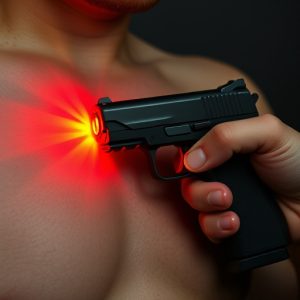Safe and Legal Stun Gun Use: A Comprehensive Guide on Impact, Selection, and Skin Contact Requirements
Stun guns are electronic devices that deliver a high-voltage, low-ampere electric charge to incapac…….
Stun guns are electronic devices that deliver a high-voltage, low-ampere electric charge to incapacitate an assailant by causing involuntary muscle contractions. Most stun guns require direct contact with the skin for optimal effectiveness, but some models have a drive stun feature that allows for a less powerful shock from a distance. It's crucial to understand the specific mechanics of your stun gun model, including its range and proper use, as well as to ensure it is charged and legal in your area. The legal use of stun guns is highly variable; some regions allow them with restrictions, while others ban them outright. It's essential to know local laws on open carry versus concealed carry, and to consult manufacturer instructions and legal experts to navigate proper usage. Safety also involves targeting large muscle groups, avoiding sensitive areas, and preventing accidental activations through proper handling and training. When considering a stun gun for personal defense, evaluate factors like voltage, amperage, design, and additional features, and ensure it's both safe and legal in your jurisdiction. Proper training is key to effectively using a stun gun in self-defense, especially addressing the question of whether it must touch skin—some modern models offer alternative options for non-contact incapacitation. Always prioritize de-escalation and personal safety as the primary approaches, with a stun gun as a last resort.
When considering personal safety devices, stun guns stand out as a non-lethal means of self-defense. Understanding their mechanics and impact is crucial for safe and effective use. This article delves into the legal aspects of stun gun ownership and provides practical safety tips that go beyond the common question, “Does a stun gun have to touch skin to be effective?” We’ll also guide you through selecting the ideal stun gun for your needs, ensuring you are well-equipped with knowledge and tools for personal protection.
Understanding Stun Gun Mechanics and Their Impact on Safety
When considering stun gun safety, it’s crucial to have a clear understanding of how these devices function. Stun guns deliver a high-voltage, low-ampere electrical charge designed to incapacitate an assailant by causing neuromuscular involuntary contractions. This disorienting effect can significantly reduce an attacker’s ability to continue a physical threat. A common question regarding stun gun use is whether contact with the skin is necessary for the device to be effective. In most cases, stun guns must make contact with the target to deliver their electrical shock; however, some models incorporate drive stun capabilities that can incapacitate an individual from a distance by delivering a lesser shock that still causes pain compliance. Understanding the mechanics of your specific stun gun model is essential for its effective and safe use. It’s important to be aware that the impact of a stun gun is not instantaneous; it may take several seconds for the full effect to occur, which allows for time to react or retreat if necessary. Safety protocols include ensuring the stun gun is charged, understanding the device’s range and aiming capabilities, and knowing the legal implications and limitations of using a stun gun in self-defense situations. Always refer to the manufacturer’s guidelines and local laws to ensure proper handling and compliance with regulations.
Legal Considerations When Owning and Using a Stun Gun
When considering the ownership and use of a stun gun for personal safety, it’s imperative to first understand the legal framework governing their use in your jurisdiction. Laws vary widely across different states and countries, with some places imposing strict regulations or complete bans on stun guns. In regions where they are legal, there are specific guidelines that dictate where and how you can carry a stun gun. For instance, it’s crucial to be aware of local laws regarding the open carrying versus concealed carry of such devices.
Moreover, understanding the mechanics of a stun gun is equally important from both a safety and legal perspective. Contrary to a common misconception, does a stun gun have to touch skin to be effective? The answer is no; modern stun guns can incapacitate a target through the interference with the nervous system, even without direct contact. This capability brings additional legal considerations into play, as the use of a stun gun must align with self-defense laws in your area. Always ensure that you are trained in the proper use of a stun gun and understand the potential consequences of its misuse. Legal ramifications can be severe if a stun gun is used improperly or without justifiable cause, so it’s essential to consult with legal experts and law enforcement to navigate these regulations correctly.
Practical Stun Gun Safety Tips for Effective Use
When considering stun gun safety, it’s crucial to understand their operation and limitations. A common question regarding stun guns is whether they need direct contact with the skin to be effective. While many stun guns require physical contact to deliver a shock, there are models designed to deliver an electrical charge through clothing in certain conditions. It’s essential to familiarize yourself with the specific capabilities of your device to use it safely and effectively. When using a stun gun, always ensure you are within a safe distance from potential threats; the effective range can vary depending on the model. Aim for large muscle groups like the torso or thighs rather than sensitive areas to minimize the risk of injury or unintended consequences. Additionally, practice holding the stun gun correctly to avoid accidentally activating it. Safety training is paramount; practice with your device in a controlled environment to ensure you understand its functions and can react appropriately during an encounter. Remember to keep your fingers clear of the probes to prevent shocking yourself, and be aware of your surroundings to avoid inadvertent contacts that could lead to unintentional discharges. Regular maintenance is also a safety aspect; ensure your stun gun is charged and functioning correctly before relying on it for protection. Understanding local laws and regulations regarding the use of stun guns is equally important, as they can vary by jurisdiction. Always prioritize de-escalation and personal safety measures as the first line of defense, using a stun gun only as a last resort.
Choosing the Right Stun Gun: Factors to Consider for Personal Safety
When selecting a stun gun for personal safety, it’s crucial to consider several factors to ensure its effectiveness and your comfort with its operation. One of the primary aspects to evaluate is the stun gun’s voltage and amperage, as these determine the strength of the electrical charge it delivers. Higher voltage and amperage can be more incapacitating, but ensure that the device you choose is legal in your jurisdiction and within the range that’s considered safe for self-defense. Additionally, consider the stun gun’s design and features, such as the ease of grip, size, and the presence of a flashlight or an alarm, which can enhance its utility in low-light conditions or help attract attention.
Another key consideration is understanding how the stun gun operates, including whether it needs to make contact with the assailant’s skin to be effective. Contrary to some beliefs, modern stun guns are often designed to deliver an incapacitating shock even if they don’t directly touch the skin; this feature is known as drive stun. This means that in a self-defense situation, you can hold the stun gun at a distance and still potentially deter or disable an attacker. It’s also advisable to choose a stun gun with clear and accessible user instructions and one that offers a non-lethal alternative for situations where your safety is at risk. Always familiarize yourself with local laws regarding stun guns, as some areas have specific regulations about their use and possession. Proper training on the use of a stun gun is equally important; it ensures you’re prepared to deploy it effectively in a self-defense scenario.


